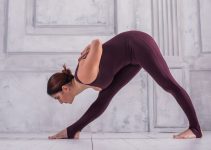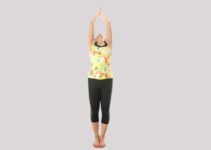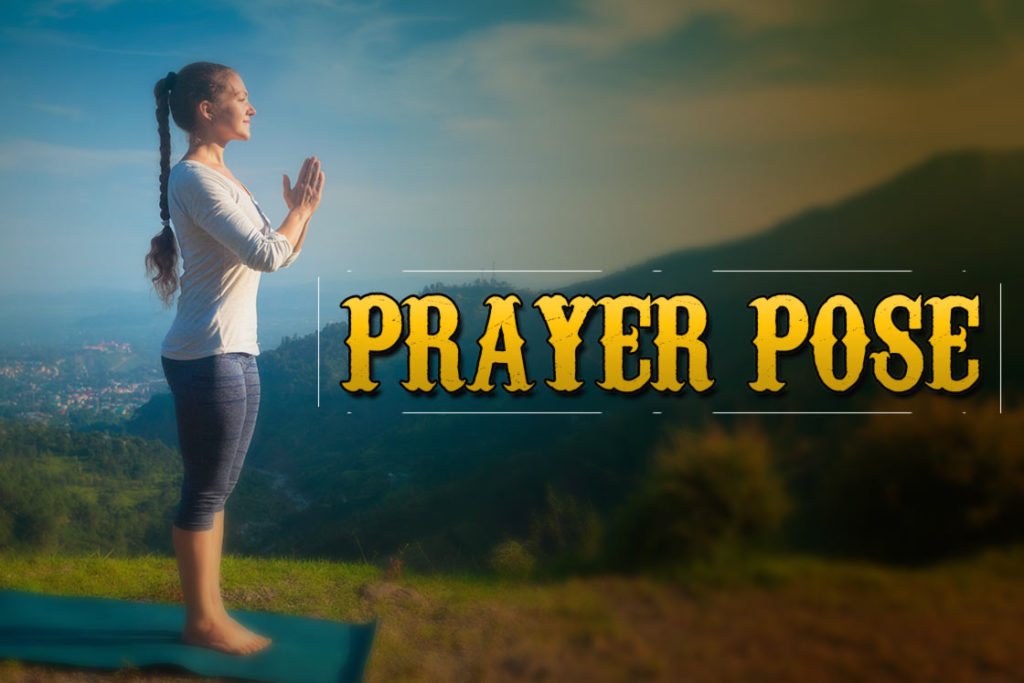
Prayer Pose (Pranamasana) is a humble gesture of respect made by bringing the palms together at the heart centre. Found in many cultures across the world, this gesture symbolises gratitude, humility, and spiritual connection.
In yoga, Pranamasana is more than a greeting it’s an offering of reverence. Practising this pose invokes a calm state of mind, opens the heart to compassion, and aligns the body with a sense of inner peace. Often used at the beginning and end of a yoga session, it marks a sacred pause that honours both the self and the practice.
Pranamasana meaning
The word Pranamasana comes from Sanskrit ‘Pra’ means before or in front of, and ‘Anama’ means to bow or bend. Together, it represents the act of bowing with respect. In yoga, Pranamasana is the gesture of offering heartfelt reverence both to the outer world and to the inner self.
The hand gesture used in this pose is known as Anjali Mudra, commonly recognised as the gesture of Namaste. It symbolises balance, humility, and a willingness to connect.
In Indian culture, joining the palms and bowing the head is a traditional way of showing respect especially to elders, parents, and spiritual teachers (gurus). This respectful gesture is not limited to Hinduism; it is also seen in Jainism, Buddhism, and other Indian spiritual traditions.
Significance of prayer pose
Being the initiatory pose of Surya Namaskara, the prayer pose pays the warming respect to the ‘God of energy’ or ‘The Sun’. This fills the spirit of the practitioner with immense confidence and power to perform further yogic practices with vigor and enthusiasm.
I honor the place in you in which the entire universe dwells. I honor the place in you which is of love, light, peace, and joy. When you are in that place in you and I am in that place in me, we are one.
– Anonymous
Prayer pose fulfills the definition of Yoga that teaches unity. By bowing down in this pose we come down to grasp the greatness of being to which we are saluting.
In Hindu tradition, Pranama represents the way to submit yourself to the elders so as to receive their love, blessings, and wisdom of years in a go. Bowing down crushes one’s ego and selflessly preventing the inner growth of an individuals’ ego. Therefore, Pranamasana resides in our day to day practice of offering, accepting, and sharing love and respect in between.
Pranamasana practice guide
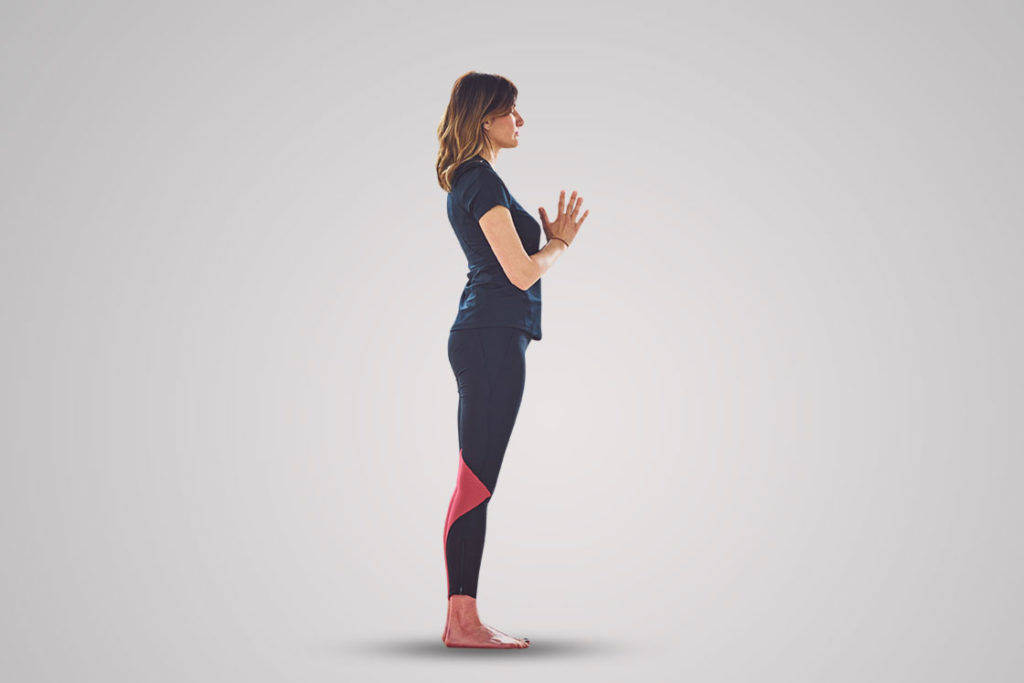
Preparatory pose
- Vajrasana (Thunderbolt Pose)
- Padmasana (Lotus Pose)
- Siddhasana (Accomplished Pose)
- Sukhasana (Easy Pose)
How to do prayer pose (steps)
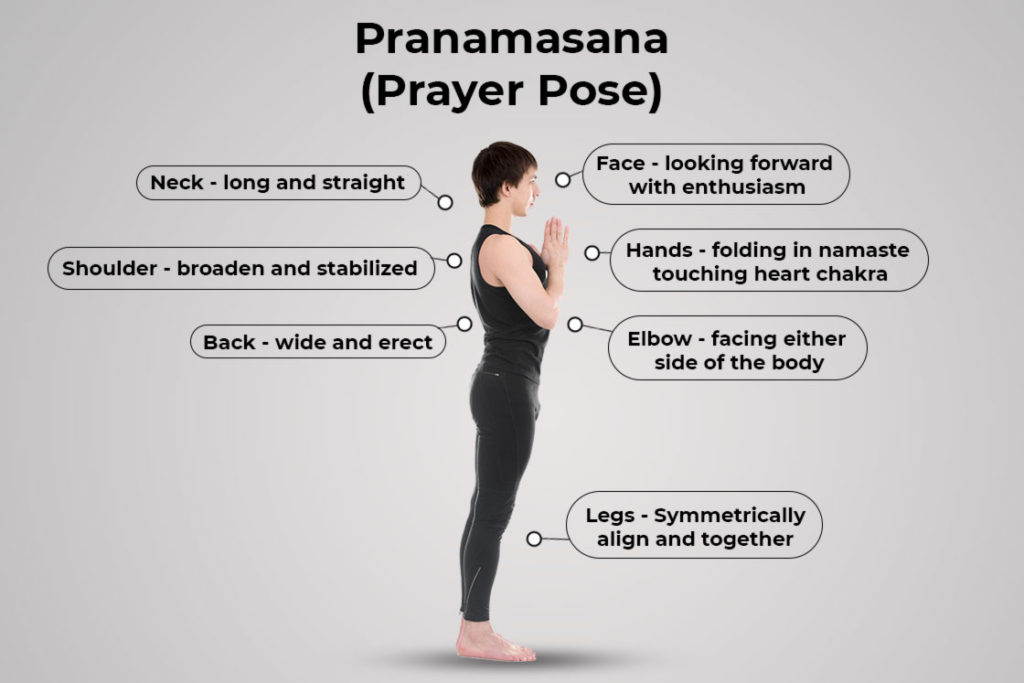
- Stand straight and your feet should be together pressing the ground firmly to support the asana.
- Now, join your hand right in front of the chest to make Namaste posture.
- Your eyes gazing straight parallel to the floor or you can close them to utter the cosmic mantras.
- From here, bring your awareness inside and breathe for 10 to 15 minutes in this posture and then relax.
Mantra Chanting
Prayer pose is the beginning and the end point of 12 poses sequence of sun salutation practice. Chanting mantra with this pose enhances the spiritual and cosmic benefits of Surya namaskar.
- In the beginning point, chant “Om mitraya namaha” (Prostration to the one who is affectionate to all).
- In the beginning point, chant “Om bhaskaraya namaha” (Prostration to the one who is the cause of light and luster).
Follow up pose
Precautions
Practitioner should keep the below points in mind before practicing Pranamsana asana. Any mistake or inefficiency of the posture would not leads to the desired objectives.
- One should not practice Pranamasana right after the meal. Minimum two to Three hours of time difference can be considered for the practice.
- Prefering sunrise over the random time period can be helpful in Pranamasana.
- Facing the sun cultivates the benefits in paramount as this pose is one of the asana of Sun salutation.
Contraindications
- One should not practice this pose in back and neck condition as bowing down could worse the condition.
- Practitioner should refrain performing Pranamasana in the later stage of pregnancy.
- Patient with ongoing high blood pressure condition avoid it for a long time.
Prayer pose variations
To deepen the practice, one can follow up the following variations of prayer pose;
1. Eka Pada Pranamasana (One-legged Prayer pose)
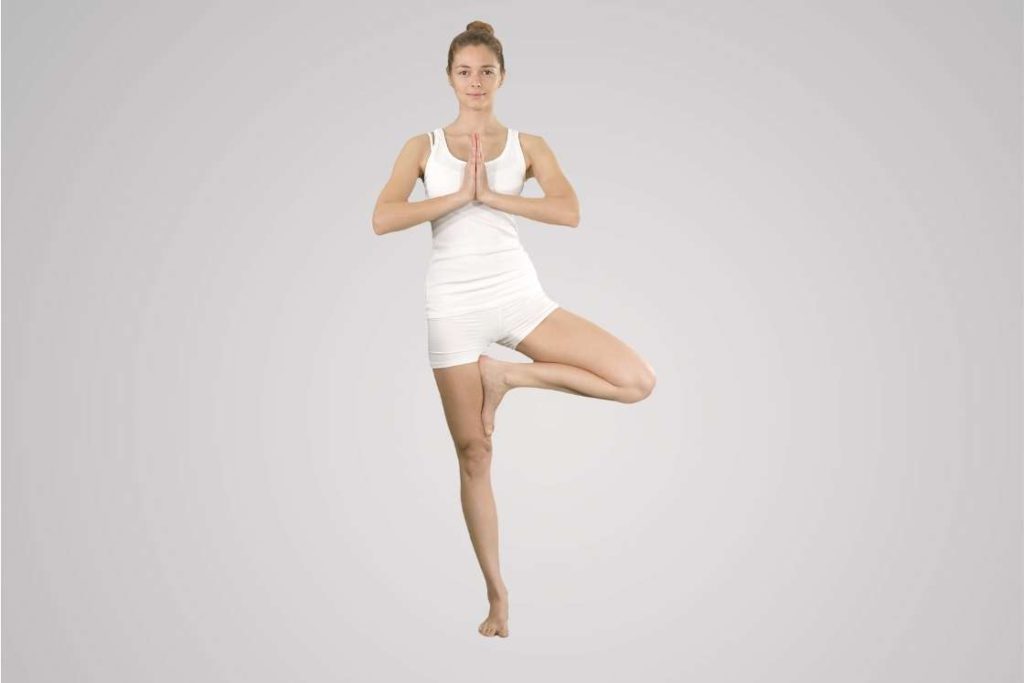
It’s similar to the standing prayer pose mentioned above rest than it’s practiced on one leg. In Eka Pada Pranamasana, one of the feet is placed on the opposite thigh near the perineum followed by the Namaskara Mudra.
- Firstly, stand straight while your feet together and your hands lie beside the hips.
- After focusing the eyes at the fixed point bend the right leg and place it on the inner left thigh.
- Make sure the right heel placed near the perineum and the right knee faces outside.
- As you find your balance here, join your hands into a prayer pose or pranam posture in front of the chest.
- Maintain the posture for few minutes and then repeat the pose with the other leg as well.
2. Urdhva Pranamasana (Upward Salute Pose)
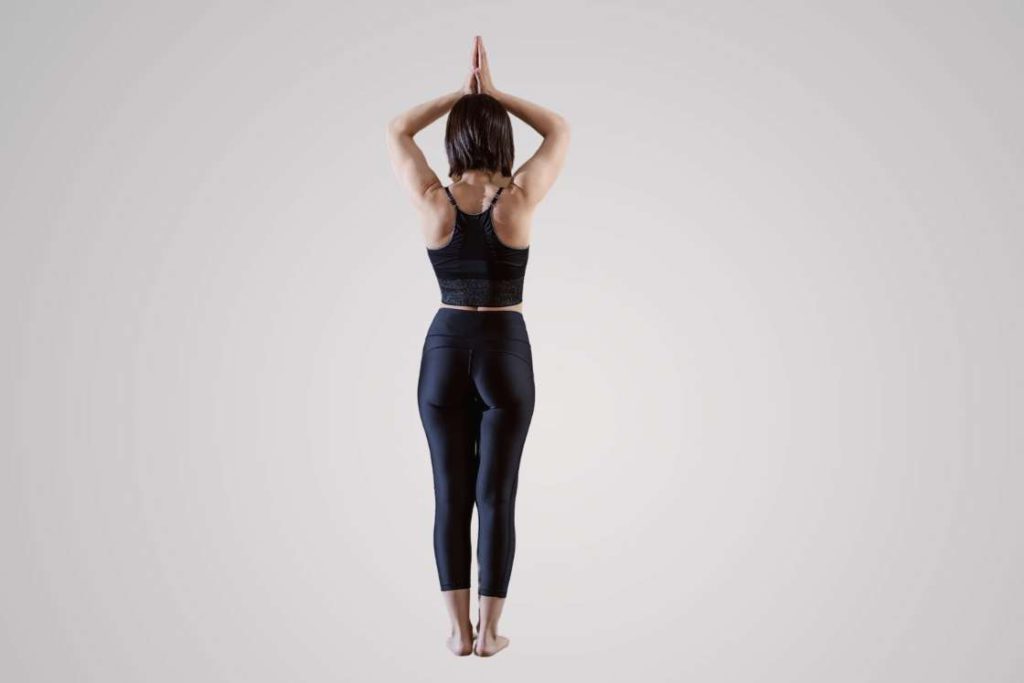
In this variation of Pranamasana, the practitioner changes the position of hands from the chest to above the head. After maintaining namaste there for some time, returns back to the Namaste Mudra on the heart.
- Stand straight with some distance between your feet.
- Inhale and raise your arms towards the sky and palms facing each other.
- Your shoulder blades are engaged and the thoracic region remains active throughout the pose.
- Now, maintain here for a few breaths and then return back to the Namaste mudra near the heart chakra.
3. Paschim Namaskarasana (Reverse Prayer Pose)
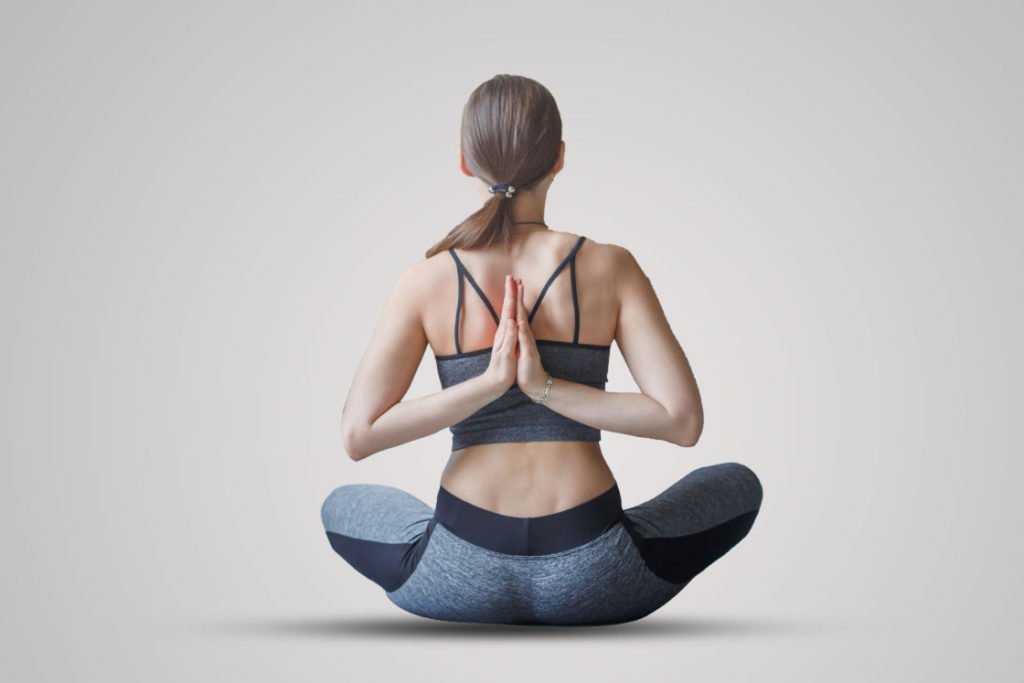
As the name is, in this variation of prayer pose hands are managed to place in the back in namaste mudra.
- Go for any comfortable sitting posture Vajrasana (Thunderbolt Pose), Sukhasana (Easy Pose).
- Now, inhale and exhale. Then, take your hands behind the back to make Prayer pose.
- Maintain the posture for some time say 10 minutes and then relax.
Benefits of prayer pose
Prayer Pose benefits include improved mental peace, activation of the heart chakra, and enhanced muscle strength and posture. It promotes emotional balance, supports spiritual growth, and helps relieve tension in the chest and upper back. Practising this pose fosters gratitude, compassion, and inner stillness.
1. Enhances mental Peace
Bowing in the prayer pose cultivates a deep sense of gratitude and humility, which has a calming effect on the mind. This gesture is linked to the release of oxytocin and endorphins chemicals responsible for feelings of emotional warmth and connection. Practising Pranamasana regularly helps reduce stress and brings inner peace.
2. Improves muscular strength
As part of the Sun Salutation sequence (Surya Namaskar), Prayer Pose contributes to building muscle endurance and strength. It engages core and lower body muscles, promoting better posture, balance, and controlled movement.
3. Support in a spiritual journey
The act of bowing in Pranamasana symbolises surrender, humility, and reverence key steps on the path of spiritual awakening. It reminds the practitioner of their connection to something greater and encourages mindful living through yogic discipline.
4. Stimulates heart chakra(Anahata)
When the palms meet at the chest, they unite Ida and Pingala Nadis at the heart centre, where the Sushumna Nadi runs. This gesture energises the Heart Chakra, promoting qualities like love, compassion, and forgiveness.
5. Strengthens the lower body
Holding the pose with aligned posture engages the legs, hips, and lower back muscles. Over time, it helps improve muscle tone and bone alignment in the lower body, especially when combined with other standing asanas.
6. Relieves tension in the thoracic region
Joining the hands at the chest with focused breathing reduces tightness in the chest and upper back. It improves blood flow in the thoracic region and encourages expansion of the rib cage, supporting deeper and more relaxed breathing.
Conclusion
In today’s fast-paced world, it’s easy to forget our deeper connection with others and the purpose of our existence. Pranamasana, or the Prayer Pose, reminds us of our shared humanity and the sacred bond that unites all beings.
By practising this simple yet powerful gesture, we reconnect with values like gratitude, compassion, and respect. It opens the heart, calms the mind, and brings us closer to the spirit of unity that lies at the core of yoga. Through regular practice, Pranamasana becomes more than a posture it becomes a path toward inner peace and universal love..
